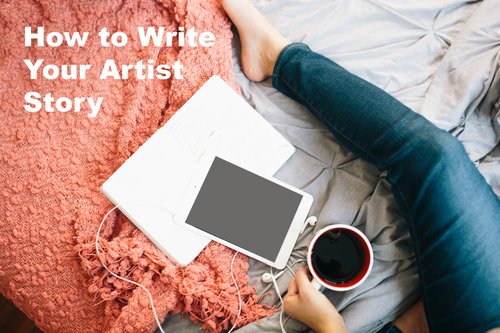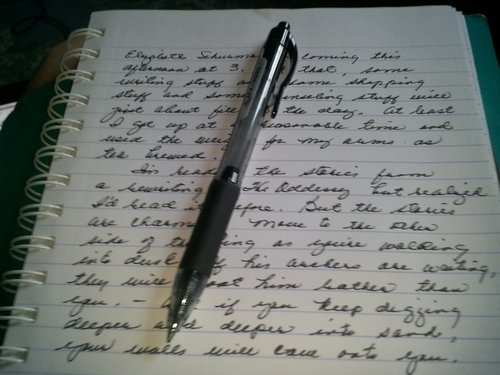by guest blogger Janet Sunderland
Stop hating conversation and communicate your passion.

I’m a writer, a memoirist and a poet, so telling my story is what I do. I don’t have to talk to people, only my screen. Unless I’m doing a public event where I have to employ the same skills as you, who prefer communicating with tools and materials rather than people.
When that happens, I have to prepare in the same way you need to prepare when you’re having a gallery show.
People buy art because 1. They like it; 2. They buy a piece of us. No, not physical slices, but think about the slice you can tell people to encourage their interest.
Take a page from my journaling and start writing. It’s called freewriting. You don’t have to worry about punctuation or making sense. You just have to get the words down so you can SEE what you didn’t know you knew.
Here’s some prompts to get you going:
- Early influences. Did you read comics and like the bright colors? Who were early influencers? Family? Friends? Teachers? How did you learn to love the colors/shapes/images you create?
- What were the conflicts or challenges to becoming an artist? How did you incorporate those conflicts/challenges? Family/friends/teachers/etc.
- How does this particular piece show or follow those early experiences? How not?
- What is your vision for your work? Is it moving in a new direction? Define the movement. Is it deepening an earlier path? Define. Are you trying new shapes/colors? Verbally define the movement your work is making. For differences, point out the connecting line of thought or vision.
- What are your plans/dreams? How do plans or dreams show up on your work? The more you are able to verbally present your passion, the easier it is for viewers to connect. Write: what is my passion? Keep writing it, over and over, until something pops out at you.

Freewriting accesses a nonlinear part of the brain. Find a comfortable place to rest your arm and comfortable writing instruments. Writing by hand in a physical movement connects with the nonlinear part of your brain more than computer writing. Write without stopping—to respell, clean up a sentence, or think. If nothing comes, make yourself write the same word over and over until something does.
Write for five minutes, keeping your pen moving. When you can push longer, do so. The longer you write and the faster you write, you’ll notice your mind hits a wall; that’s the wall where treasures lie. Keep your pen moving, write anything, and the secret message will pop out.
Sort of like those hidden message things we used to rub pencil over when we were kids.
After you write, outline your ideas, and practice out loud. There’s too much stuff going on at a gallery opening. When you practice out loud, (without notes) you will feel natural and sound natural because you have practiced enough to have the right words in each situation.
And the last two pieces of advice? Trust yourself and Keep your sense of humor. A sense of humor, dark humor included, makes us all happier (and it could charm your buyer!).
 Janet Sunderland grew up on a farm in Marshall County, Kansas and drifted like a cottonseed across the United States, Europe, Mexico, and the Caribbean before moving to Kansas City with her husband, Cliff Kroski. She is poet, a memoirist, and an editor.
Janet Sunderland grew up on a farm in Marshall County, Kansas and drifted like a cottonseed across the United States, Europe, Mexico, and the Caribbean before moving to Kansas City with her husband, Cliff Kroski. She is poet, a memoirist, and an editor.


I have been entertaining by drawing cartoons, not caricatures, for exhibitors at trade shows coast to coast for over 40 years. People often ask me when did I first make money drawing. It was in elementary school. My older brother would sneak Playboy magazines in to our house. I loved looking at the pinup drawings by Vargas. He painted gorgeous, half naked women that I admired. I wanted to be able to draw a woman that looked so sexy. I would be in class trying to draw like Vargas, and some guy would give me their lunch money for my sketch.
Great story, Charles! Made me grin. And then I wondered about the audience for this story and saw a little, white-haired grandmother admiring your work as she waited for her busy grandchild, and saying, how did you learn to draw, young man? Bet you’re quick enough to come up with an edited version!
Thanks so much for responding. J.
man ray’s advice to young artist’s was to learn how to talk about your work. the more you understand the better, no, the richer your work will be. follow janets excellent outline. my advice to young artist is to not get hung up on the questions you are being asked or other peoples observations, if they are demeaning or dismissive. when someone asks you a question, they have given you the floor. talk about what YOU want to talk about. and don’t forget to listen to youself and others. it’s a big world be a part of it, and listen
Thanks, Willy! What a great reminder to learn to listen. Which, of course, means getting out of one’s head long enough to hear. I suppose, all in all, the challenge for all of us is to really listen for what others seem to want to hear from us, whether ideas or technique.
J.
I’m glad to learn more of your wide array of gifts. I take to heart your advice to trust myself and keep my sense of humor. Wise words. <3
Thank you! So glad you enjoyed the piece. My mother taught me to have a sense of humor; and “trust” has been my word for years and years. It’s seemed to work.